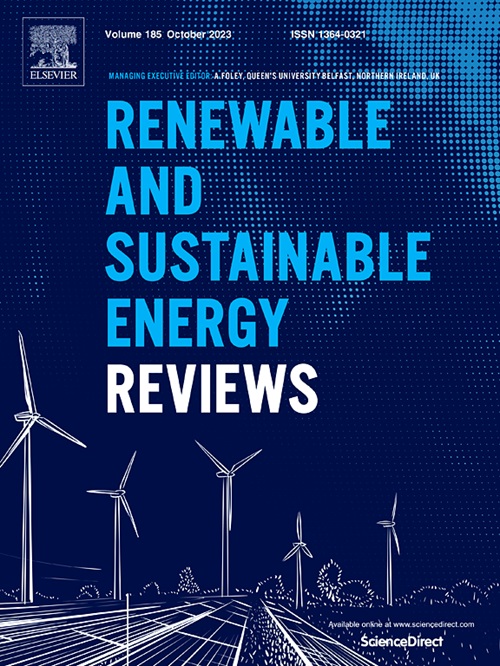利用热解-气相色谱/质谱法分析生物质热解
IF 16.3
1区 工程技术
Q1 ENERGY & FUELS
引用次数: 0
摘要
目前,分析热解在研究生物质转化为化学品和生物燃料方面显示出巨大的潜力,其中最引人注目的是热解器与气相色谱/质谱联用(Py-GC/MS)技术。本综述旨在总结使用 Py-GC/MS 进行的不同方法(即传统热解、分步热解和催化热解),以及所得产物的成分和分布。首先,根据典型化学成分(即纤维素、半纤维素、木质素、蛋白质和脂质)的分析热解,总结了基本可信的热解机理。对于利用 Py-GC/MS 进行的传统热解,讨论了生物质类型和操作参数的影响,结果表明,生物质类型和最终温度在调节产物成分和分布方面起着主导作用。随后,通过分步热解的 Py-GC/MS 实验揭示并讨论了不同阶段的产物释放行为。不同的分步热解方法(高温分解和热解、两步热解和多步热解)的主要目的是生产增值化学品或提高生物油的质量。此外,还总结并比较了各种催化剂(包括可溶性无机盐、金属氧化物、微孔沸石和介孔沸石)的催化效果,以阐明催化剂在催化热解过程中的作用,从而实现目标产品的生产。在此基础上,还提出了分析热解应用的潜在实际意义和目前存在的局限性,目的是提高 Py-GC/MS 在未来应用中的有效性。本文章由计算机程序翻译,如有差异,请以英文原文为准。

Analytical pyrolysis of biomass using pyrolysis-gas chromatography/mass spectrometry
Analytical pyrolysis is currently showing tremendous potential for investigating biomass conversion into chemicals and biofuels, of which the most notable is the pyrolyzer coupled with the gas chromatography/mass spectrometry (Py-GC/MS) technique. This review aimed to summarize the different approaches (i.e., conventional pyrolysis, stepwise pyrolysis, and catalytic pyrolysis) conducted using Py-GC/MS, as well as the composition and distribution of resulting products. The basic plausible pyrolysis mechanisms were first summarized based on the analytic pyrolysis of typical chemical components, i.e., cellulose, hemicellulose, lignin, protein, and lipid. As for the conventional pyrolysis proceeded by using Py-GC/MS, the influence of biomass types and operation parameters was discussed, which indicated that biomass types and final temperature played a dominant role in regulating the composition and distribution of products. Subsequently, the product release behaviors at different stages were revealed and discussed via Py-GC/MS experiments using stepwise pyrolysis. The primary objectives of different stepwise pyrolysis approaches (torrefaction and pyrolysis, two-step pyrolysis, and multi-step pyrolysis) were to produce value-added chemicals or increase bio-oil quality. Furthermore, the catalytic effects of various catalysts, including soluble inorganic salts, metal oxides, microporous zeolites, and mesoporous zeolite, were also summarized and compared to elucidate the role of catalysts in catalytic pyrolysis for targeted product production. Based on the above, the potential practical implications and current limitations that exist in the application of analytical pyrolysis were also proposed, with the aim of improving the effectiveness of Py-GC/MS in future applications.
求助全文
通过发布文献求助,成功后即可免费获取论文全文。
去求助
来源期刊

Renewable and Sustainable Energy Reviews
工程技术-能源与燃料
CiteScore
31.20
自引率
5.70%
发文量
1055
审稿时长
62 days
期刊介绍:
The mission of Renewable and Sustainable Energy Reviews is to disseminate the most compelling and pertinent critical insights in renewable and sustainable energy, fostering collaboration among the research community, private sector, and policy and decision makers. The journal aims to exchange challenges, solutions, innovative concepts, and technologies, contributing to sustainable development, the transition to a low-carbon future, and the attainment of emissions targets outlined by the United Nations Framework Convention on Climate Change.
Renewable and Sustainable Energy Reviews publishes a diverse range of content, including review papers, original research, case studies, and analyses of new technologies, all featuring a substantial review component such as critique, comparison, or analysis. Introducing a distinctive paper type, Expert Insights, the journal presents commissioned mini-reviews authored by field leaders, addressing topics of significant interest. Case studies undergo consideration only if they showcase the work's applicability to other regions or contribute valuable insights to the broader field of renewable and sustainable energy. Notably, a bibliographic or literature review lacking critical analysis is deemed unsuitable for publication.
 求助内容:
求助内容: 应助结果提醒方式:
应助结果提醒方式:


